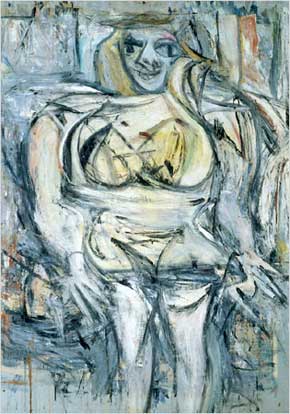Willem De Kooning
As one of the most important and influential members of the Abstract Expressionist movement, Willem de Kooning has drawn upon a variety of sources such as Cubism, Surrealism and Abstraction to create his own original and highly complex visions. Throughout the course of his career, he has focused on two themes--the human figure, especially women, and landscape--producing powerful, inventive and sometimes controversial images. As well as having a profound influence on American art, his work has had a vital impact on artists throughout the world, contributing to his  international reputation as one of the masters of twentieth century painting.
international reputation as one of the masters of twentieth century painting.
Born in Rotterdam in 1904, De Kooning left grammar school at the age of twelve to begin an apprenticeship with a local commercial art and decorating firm owned by Jan and Jaap Giddings. He also enrolled in evening classes at the Academie voor Beeldende Kunsten en Technische Wetenschappen, where, for the next eight years, he received a rigorous academic training. Taking courses in both the fine and applied arts, he drew from live models and plaster casts and studied anatomy, perspective, lettering and wood-graining. In 1920, De Kooning left the Giddings firm to work for Bernard Romein, an art director for a department store. It was about this time that he began to familiarize himself with artists such as Piet Mondrian, Jan Toorop, and the De Stijl group, as well as Jugendstijl, the School of Paris and architect Frank Lloyd Wright.
De Kooning spent 1924 in Belgium, studying at the Académie Royale des Beaux-Arts in Brussels and at the Van Schelling Design School in Antwerp. Two years later he emigrated to the United States, settling in Hoboken, New Jersey, where he worked as a house painter and carpenter. One year later he moved to Greenwich Village, supporting himself by doing commercial art, display signs and other related jobs. After coming into contact with a coterie of progressive-minded painters that included Stuart Davis, John Graham and Arshile Gorky, he began experimenting with techniques of color abstraction inspired by Picasso’s late Cubism, as well as by the work of Wassily Kandinsky. Throughout the 1930s, De Kooning painted portraits and figure studies, including a series of haunting canvases of standing and seated men in interiors. Towards the end of that decade, he also produced abstractions featuring organic and biomorphic forms, investigating the Surrealist concept of automatism. Gorky, who had created his own personal style based on European Surrealism, remained a key influence on De Kooning’s early work. During these years, he also established friendships with the poet and dance critic Edwin Denby, composer Aaron Copland, and painter-photographer Rudolph Burckhardt. He also worked briefly for the WPA Federal Art Project (1935) and painted a section of a mural for the New York World’s Fair Hall of Pharmacy (1937).
In 1938, De Kooning painted his first canvases of Women, a subject he would explore throughout his career, interpreting the female form as an erotic symbol, a ferocious vampire or as a primitive deity and fertility goddess. Around this time, De Kooning became closely associated with a group of artists that included painters Jackson Pollock, Franz Kline, Philip Guston and Clyfford Still and sculptor David Smith, all of whom became part of the so-called New York School.
In 1943, De Kooning married the painter Elaine Fried. Five years later, he had his first one-man show at the Charles Egan Gallery in New York, exhibiting a group of black and white abstractions that established his reputation as a leading American painter. Indeed, along with Pollock, he became the unofficial spokesman of the Abstract Expressionists, helping develop the style known as “gestural” or “Action” painting. Although De Kooning shared the group’s interest in Surrealism, with its emphasis on automatism, intuition and free association, his work stood apart from that of his contemporaries in its concern for spatial organization, the movement of line and form and its expressive and highly energized brushwork. De Kooning went on to produce dazzling, vigorously painted canvases. Some, such as Night Square (1951; Private collection) were pure abstractions, while others, notably Montauk I (1969; Wadsworth Athenaeum, Hartford, Connecticut), had suggestions of figures or fragments of figures in the backgrounds. During the 1970s, De Kooning also explored the figure in bronze, interpreting his subject with rich, spontaneous modeling.
 Woman III Willem De Kooning Oil and Charcoal on Canvas 1953 68 x 48 1⁄2" |
 Woman V Willem De Kooning Oil and Charcoal on Canvas 1953 61 x 46" |
De Kooning taught at Black Mountain College in North Carolina in 1948 and at Yale University during the 1950-1951 academic year. He became an American citizen in 1962. His awards and prizes include the Andrew W. Mellon Prize at the Carnegie International in Pittsburgh, which he shared with the painter Eduardo Chillida in 1980. De Kooning lived and worked in New York City until 1963, when he moved to The Springs in East Hampton, Long Island. He continued to reside there until his death on March 19th, 1997.
A member of the National Institute of Arts and Letters, Willem de Kooning is represented in major public collections throughout the United States and abroad, including the Solomon R. Guggenheim Museum, New York; the Museum of Modern Art, New York; the Metropolitan Museum of Art, New York; the Whitney Museum of American Art, New York; the Albright-Knox Art Gallery, Buffalo; the Art Institute of Chicago; the Hirshhorn Museum and Sculpture Garden, Washington, D.C.; the Walker Art Center, Minneapolis; the Carnegie Museum, Pittsburgh; the Stedelijk Museum, Amsterdam; the Tate Gallery, London; and the Australian National Gallery, Canberra, to name only a few.
He has been the subject of numerous retrospective exhibitions, most recently Willem de Kooning from the Hirshhorn Museum Collection, held at the Hirshhorn Museum in Washington, D.C. in 1993 and Willem de Kooning: Paintings, organized by the National Gallery of Art in Washington, D.C. (circulating exhibition 1994-1995).


